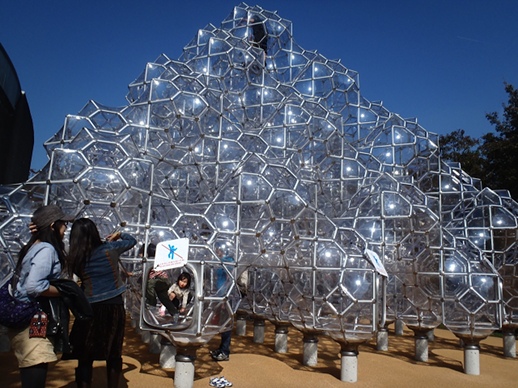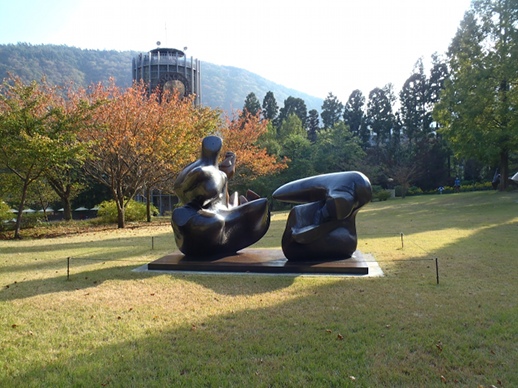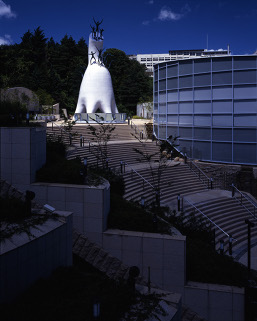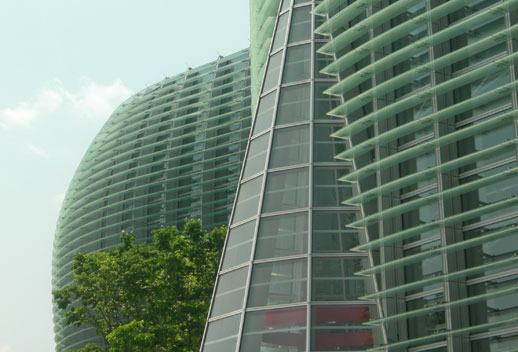Goodbye Kitty
There’s no questioning the wealth of entertainment for kids in this city. And no doubt if you’re a parent you’ve given them all your best shot.
You’ve queued for two hours in the August sun for Thunder/Splash/Space Mountain, only to be rendered speechless and slightly queasy. You’ve slid down water slides, been to every dinosaur, train, aeroplane and science exhibition, zoo and planetarium with every other parent and their gaggle of kids, and may by now have rather a fine collection of photos with life-sized Hello Kitties and all her little furry friends.
But enough is enough, it’s time to expose the kids to some of the finer things in life, and introduce them to the world of art. But where to start?
Ghibli Museum
Behind the doors of the colourful Ghibli Museum building, the world of Hayao Miyazaki’s imagination is waiting to be discovered.
A delightfully crafted building, with fresco paintings, stained glass windows, a maze of spiral staircases, bridges and terraces, visitors are instantly transported to the animated worlds of the Ghibli films. Under twelves can rumble and tumble in the (almost) life size Cat Bus from “My Neighbour Totoro”, play with the Dust Bunnies, and stand in awe of the five-metre tall Robot Soldier. In the Saturn Theatre, exclusive original animated short films are shown, and through the transparent screen visitors can see how a projector works. Older kids and adults may also enjoy browsing through the book collection in the Tri-Hawks Library, and as you walk through the exhibition rooms of the first floor, discover how an animated film is made.
The museum makes for a perfect morning or afternoon visit, and situated on the edge of Inokashira Park, can easily be combined with a visit to the nearby zoo. Do note, that tickets must be booked in advance.
www.ghibli-museum.jp

Suginami Animation Museum
Not far from the Ghibli Museum is lesser-known Suginami Animation Museum. Perhaps created as much for the manga otaku as for kids, it is none the less worth a visit should you have an interest in anime.
With information in both English and Japanese, push button displays introduce visitors to the basics of anime and replicas of the working desks of famous animators show where it all began. The best fun to be had is the hands-on activities — we made our own flipbook cartoon and saw it come to life on a computer screen within minutes of completion, and though my impression of Astro Boy was not entirely appreciated, much fun was to be had in the dubbing experience booth. As well as this, there is an anime theatre showing various classics, and an anime library where you can choose your favourite DVD and sit down to a private viewing with headphones. All for free it’s a fun little low-key place to learn and explore about anime.
www.sam.or.jp
For those who might wish to explore the world of anime museums in more detail, JNTO has a handy anime map which can be downloaded.
Another great way to introduce kids to art without having to tell them to “Shush” every five minutes is to take them to outdoor displays. Here are two that I would thoroughly recommend.
Edo Open Air Architectural Museum
Located in the west of Tokyo, an easy bus shuttle ride from Koganei, this is a spacious and chilled-out place to learn about architecture or (and perhaps more importantly) imagine you have been transported back in time to Edo-Tokyo.
The buildings are all original structures, relocated to the seven-hectare park, where they have been lovingly reconstructed and preserved. Roam the grounds and enter the buildings at your leisure — from thatched roof farmhouses to turn of the century residential houses. And for the real atmosphere of downtown Edo head for Shitamachi-naka Street for some virtual window-shopping. For some unexplainable reason my daughter and her wee pal always end up sitting in the bath house (empty, I should add) and with a classic Fuji mural in the background, chattering away like a couple of regulars to their hearts’ content. Soba noodles for lunch, and green tea for sweets, or bring a picnic. You could easily spend a pleasant morning or afternoon here. Located within the grounds of Koganei Park, it’s a pleasant day out for all the family. The Bon Festival in August is a real step back in time, and well worth a visit.
www.tatemonoen.jp

Hakone Open Air Museum
A visit to this fantastic sculpture park could easily be a whole day out for the family. Arm yourself and the kids with the audio guide and interactive map available in both Japanese and English, and enter a land littered with — according to the guide — 120 artworks. Famous names like Moore, Balzac, Okamoto and Picasso are all here. Some personal favourites were Bukichi Inoue’s ‘My Sky Hole’, a giant metal ball bearing suspended above your head, the mesmerizing ‘16 Turning Sticks’ by Takamichi Ito, Niki de Saint Phalle’s ‘Miss Black Power’ (the big statue on all the museum posters), and the tranquil ‘Floating Sculpture’ by Marta Pan. Curious delights await you, and this is a fun, but also highly impressive collection. Recent additions of the Curved Space Diamond Structure, a plastic honeycomb climbing adventure for pre-schoolers and primary school kids, Woods of Net and its colourful hammock-like trampoline playground, as well as the Manz Room where kids can play in mini versions of the real thing, will all keep younger kids entertained.
Foot baths for weary feet, buffet-style lunch to fill up hungry tummies: you simply can’t go wrong here. Ninety minutes from Shinjuku, it could be done in a day, though I would recommend an overnight stay if possible, and do the more touristy things (such as eating stinky black eggs if you so desire) on the other day.
www.hakone-oam.or.jp
There are many other museums to be visited in Hakone. If you have an hour or two to spare, the Museum of the Little Prince is worth a visit. More a museum to author Saint-Exupery than the Little Prince himself, it is a charming make-believe world worth an hour or so.

Walk through the red hallway at the entrance of this museum and be transported to the weird and wonderful world of Taro Okamoto. While the paintings themselves may not be quite enough to keep the kids’ attention, the design of the museum encourages children to explore and find exhibits that are less obvious.
At the section of the museum which charts the history of Okamoto’s work and requires longer attention than kids may be capable of, a glass hole in the floor reveals a hidden clock to distract their attention, as well as a wall with peep holes at heights for all sizes through which children (and adults too of course) can view miniature pictures of his various artwork and sculpture. And chairs a-plenty: lip-shaped chairs, hand-woven chairs and chairs that simply refuse to be sat on. Life-sized cardboard cut outs of the surprisingly small Okamoto make for some fun pics, as does the cardboard cut out of the Tower of the Sun. Outside is the huge ‘Tower of Mother’ and plenty of room to run around.
www.taromuseum.jp
It is a little out of town for some perhaps, but could easily be combined with a visit to the Japan Open-Air Folk House Museum, or the Planetarium at the Kawasaki Municipal Science Museum for Youth. (Unfortunately closed right now, but due to open again in 2012).
Mori Art Museum
Located on the 53rd floor of Roppongi Hills, exhibitions here are temporary, and do vary, though always of a modern contemporary flavour. With three to four exhibitions a year it might be worth checking out just exactly what the exhibit is, depending on the age of your child.
As admission to the museum includes entry to Tokyo City View, and for a mere 300 yen extra to go on the roof, even the most art-allergic kids could be persuaded on a quick detour to the gallery, and who knows they might even enjoy it. Kids’ tours are only in Japanese, but audio guides are available in English.
www.mori.art.museum

The National Art Center
While I wouldn’t recommend bringing boisterous pre-schoolers to this place, it is definitely a space that inspires calm and wonder. A short walk from the Mori, there are three floors of galleries, a café, two restaurants and plenty of well-lit ambient space in which to unwind. Exhibitions vary greatly here, and it can sometimes feel like feast or famine. Saying that, this is certainly the place where you are most likely to find Japanese Fine Art and contemporary university graduate exhibitions all under the one roof. Did I mention the shop — oh, lots of goodies there!
www.nact.jp
It is also worth checking out the websites of the Museum of Contemporary Art and the National Museum of Western Art as both provide a number of children-orientated events throughout the year. Though largely in Japanese, it does encourage children to get to know more about the galleries through guided talks and more hands-on type workshops.
Though a visit to any or all of the above might not guarantee an end to your family trips to Disney, I am sure it will do far more to trigger your child’s imagination and ignite their curiosity. It’s certainly worth a go, and will make for a pleasant change for theme-park weary parents.
Check TAB for up-to-date kids-friendly events.
Carolyn Hashimoto
Carolyn Hashimoto



